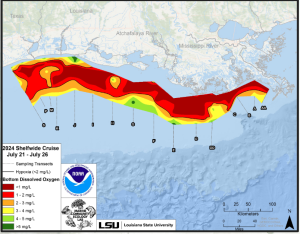41 Impact on the Environment: Agricultural Runoff
Eutrophication & Dead Zones:
Agricultural runoff is one of the leading contributors to water pollution in the U.S., and one of its most damaging effects is eutrophication. This process occurs when bodies of water—like lakes, rivers, and coastal zones—receive excess nutrients, primarily nitrogen and phosphorus. These nutrients often come from fertilizers or animal waste used in farming. When it rains, they are carried from fields into nearby waterways, setting off a chain reaction that disrupts aquatic environments (Sharpley et al., 2003). (CK)
Once in the water, the nutrients fuel rapid algae growth, leading to what’s known as an algal bloom. While not all blooms are dangerous, many are classified as harmful algal blooms (HABs) due to the toxins they produce. Even when non-toxic, these blooms can smother aquatic ecosystems. Thick layers of algae block sunlight from reaching underwater plants, which need light for photosynthesis. As those plants die off, the animals that depend on them—either for food, oxygen, or shelter—begin to suffer too. (CK)
The situation worsens when the algae themselves die. Their decomposition consumes oxygen in the water, reducing the amount available to other organisms. As oxygen levels drop, aquatic environments can become hypoxic (low oxygen) or even anoxic (no oxygen). In these conditions, most marine life cannot survive. The result is a “dead zone”—an area where life either flees or dies off entirely (U.S. Environmental Protection Agency, 2024). (CK)
Case Study: Gulf of “America”
One of the most well-known examples of this phenomenon is the recurring dead zone in the Gulf of “America”. Each summer, a large stretch of ocean near the coasts of Louisiana and Texas becomes oxygen-depleted, largely due to nutrient runoff traveling down the Mississippi River. The river collects agricultural waste from more than 30 states before emptying into the Gulf. There, the nutrients spark intense algal growth. (CK)
As with other eutrophic systems, the bloom eventually collapses. As the algae break down, oxygen is stripped from the water, and marine animals—like fish and shrimp—are either forced to migrate or die. In 2020, the dead zone in the Gulf spanned approximately 6,000 square miles—an area about the size of New Jersey (NOAA, 2020). (CK)
This has serious consequences. Local fisheries are especially vulnerable, as their livelihoods depend on healthy, thriving aquatic life. Shrinking harvests can hurt coastal economies, reduce food supply, and put more strain on already fragile ecosystems. (CK)
Figure 4 highlights the seriousness of this issue by showing a map of the Gulf, with red areas marking spots where oxygen levels are dangerously low, under 1 mg/dl. These are the regions most affected by the Dead Zone, leaving little room for marine life to survive. (CK)

Taking Action: The Hypoxia Task Force
To combat nutrient pollution in the Mississippi River Basin, several conservation practices have been adopted. These include:
-
-
Cover Cropping: This is when farmers plant crops like clover or rye during the off-season to keep the soil covered. These plants help stop erosion, keep moisture in the soil, and absorb extra nutrients that could otherwise wash away into rivers and streams, which would pollute the water (SARE, n.d.).
-
Wetland Restoration: Wetlands are areas that filter water naturally. Restoring wetlands means bringing back places that have been drained or damaged. These wetlands trap pollutants like excess nutrients and help prevent them from reaching rivers and lakes. They also provide wildlife habitats and help prevent flooding by soaking up extra rainwater (EPA, 2016; USGS, 1996).
-
Better Fertilizer Use: This practice ensures that farmers apply the right amount of fertilizer at the right time so that crops get what they need without excess fertilizer running off into nearby water. This helps protect water quality and ensures crops grow well (EPA, 2016).
-
Through strategies like cover cropping, wetland restoration, and improved fertilizer management, farmers are helping to protect not only their land but also the health of the entire Mississippi River Basin and the Gulf of America. The Hypoxia Task Force has set a clear and ambitious goal: reduce the Gulf’s dead zone to less than 5,000 square kilometers by 2035 (Hypoxia Task Force, 2024). Achieving this will require continued collaboration and commitment from everyone involved. (CK)
